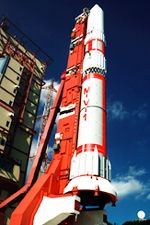Brief History
 In
April, 1955, the Institute of Industrial Science, University of Tokyo,
conducted an experiment to launch the 23 cm-long Pencil rocket. This was
Japan's first step toward the completion of the indigenous sounding rocket
upon participating in the IGY (International Geophysical Year) activities
from 1957 to 1958. It also marked the start of Japan's space activities
and the origin of the present Institute of Space and Astronautical Science. In
April, 1955, the Institute of Industrial Science, University of Tokyo,
conducted an experiment to launch the 23 cm-long Pencil rocket. This was
Japan's first step toward the completion of the indigenous sounding rocket
upon participating in the IGY (International Geophysical Year) activities
from 1957 to 1958. It also marked the start of Japan's space activities
and the origin of the present Institute of Space and Astronautical Science.
Japan's participation in the IGY events ended in success
by carrying out observations of the upper atmosphere, cosmic rays, and
others. Those observations were possible by the development of K-6 type
rockets, which could reach as high as 60 km in altitude, with the use
of solid propellant. This success was followed by further improvement
of the rocket performance through the development of K-8 type and others,
which opened the way toward the era of space observation by the 1960s
with the use of sounding rockets. In 1962, Kagoshima Space Center was
established and opened as a full-scale launch site.
Meanwhile, following recommendations by the Science Council
of Japan, the Institute of Space and Aeronautical Science, University
of Tokyo, the predecessor of the present ISAS, was established in 1964
to further promote space science in Japan by following the successful
path of the Institute of Industrial Science. Since then, the ISAS, as
an inter-university joint research facility, has become a core organization
of Japan's space activities along with the National Space Development
Agency (NASDA), which was established in 1969 to take charge of applicational
programs, under the Space Activities Commission (SAC), established in
1968.
At the same time, as a natural consequence of the development
of technologies for sounding rockets, demand arose to carry out scientific
observations with the use of satellites. The project to develop the M-4S
rocket for launching scientific observation satellites was approved in
1966 under such circumstances. After trial and error, the L-4S rocket,
the development of which was planned to verify the orbit injection method
of the solid four-stage M-series rockets, finally succeeded in launching
Japan's first satellite, OHSUMI, on February 11, 1970.
Based on the success of this L-4S rocket, the M-4S rocket
completed its virgin flight in February, 1971. In September of the same
year, the first scientific satellite, SHINSEI, was launched and carried
out observations of solar radio emissions, cosmic rays, and the ionosphere,
marking the beginning of the era of scientific satellites in Japan. Since
then, steady progress has been made in the improvement of the M series
rockets while launching almost one scientific satellite per year. Against
such background, Japan was able to have a number of successful results
in the field of scientific observation. The X-ray astronomy satellite,
HAKUCHO, is one example.
As activity in the field of scientific observation in space
increased rapidly, the Institute of Space and Aeronautical Science, University
of Tokyo, was reorganized in 1981 to become the Institute of Space and
Astronautical Science (ISAS) under the direct control of the Ministry
of Education. Through the reorganization, activities were further strengthened,
reflecting the demands by the researchers of space science throughout
the entire country. Meanwhile, NASDA succeeded in launching the Engineering
Testing Satellite, KIKU, in 1975 by its N-I rocket, which was developed
through the transfer of technologies used for the US Delta-Thor rockets.
The year 1985 turned out to be a memorable one for the reborn
ISAS. In January, the first M-3SII rocket, still under development at
the time, successfully launched the SAKIGAKE probe to Halley's comet.
Together with the SUISEI, which was launched in August of the same year,
SAKIGAKE succeeded in nearby observation of the comet as part of the "Halley
Armada" of spacecraft from Japan, the US, Europe, and the Soviet Union.
The newly constructed 64 m antenna demonstrated its capability to the
full. With the technologies for orbit planning, orbit determination, and
in-orbit operation established, Japan acquired the capability for interplanetary
navigation. The occasion of the Halley mission led to the establishment
of the IACG (Inter-Agency Consultative Group), which is still extremely
effective in functioning as a cooperative organization among Japan, the
US, Europe, and Russia.
 |
Since then, ISAS has scored a series of successes
with its projects, such as: the X-ray astronomy satellite, GINGA;
the scientific satellite, AKEBONO, for the observation of northern
lights; HITEN, to conduct lunar swingbys; YOHKOH, for solar observation;
and the X-ray astronomy satellite, ASCA. Such splendid results were
possible with the establishment of the constant level of high performance
of the M-3SII and of the credibility of its satellites. Apart from
GINGA, which reentered the atmosphere, and HITEN, which fell onto
the moon, all the above satellites are currently continuing their
missions along with the scientific satellite, GEOTAIL, launched
in 1992 through Japan-US cooperation for the study of solar-terrestrial
system.
Considering scientific satellite missions as its core
activities, ISAS has obtained sound results. This has been possible
by launching medium- and small-size satellites at appropriate intervals.
While continuing with this strategy to launch satellites, ISAS developed
the launch vehicle of the next generation, M-V, and opened a new
era for more substantial observations with this vehicle. The first M-V
launched the world's first space VLBI satellite, HALCA. M-V then sent NOZOMI (Mars), HAYABUSA (asteroid), SUZAKU (X-ray), AKARI (infrared) and HINODE (sun) into orbit, and was ordered by the government to cease development. |
|